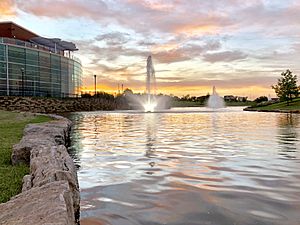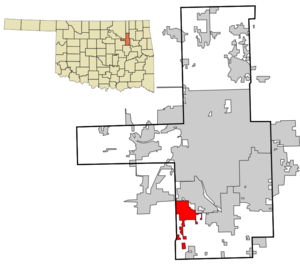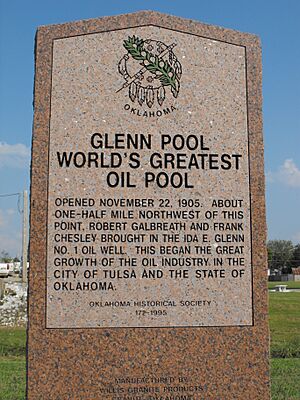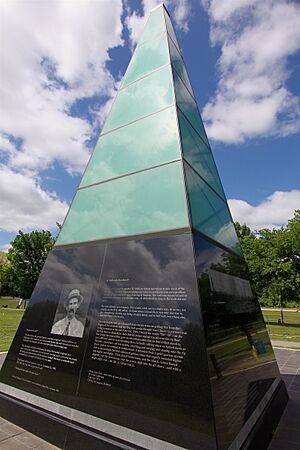Glenpool, Oklahoma facts for kids
Quick facts for kids
Glenpool, Oklahoma
|
|
|---|---|

The Glenpool Conference Center
|
|
| Motto(s):
"Creating Opportunity"
|
|

Location of within Tulsa County, and the state of Oklahoma
|
|
| Country | United States |
| State | Oklahoma |
| County | Tulsa |
| Government | |
| • Type | Mayor-Council |
| Area | |
| • Total | 11.04 sq mi (28.58 km2) |
| • Land | 11.04 sq mi (28.58 km2) |
| • Water | 0.00 sq mi (0.00 km2) |
| Elevation | 705 ft (215 m) |
| Population
(2020)
|
|
| • Total | 13,691 |
| • Density | 1,240.58/sq mi (479.00/km2) |
| Time zone | UTC-6 (Central (CST)) |
| • Summer (DST) | UTC-5 (CDT) |
| ZIP code |
74033
|
| Area code(s) | 539/918 |
| FIPS code | 40-29600 |
| GNIS feature ID | 1102843 |
Glenpool is a city in Tulsa County, Oklahoma, United States. It is part of the larger Tulsa area. In 2020, about 14,040 people lived there. This was a big jump from 2010, when the population was 10,808.
Glenpool is famous because oil was found there in 1905. This discovery caused a huge economic boom. It helped the city of Tulsa and the surrounding areas grow very quickly. The oil field, called the Glenn Pool Oil Reserve, still produces a little oil today. However, Glenpool is now mostly a commuter town. This means many people who live in Glenpool travel to Tulsa for work.
Contents
History of Glenpool
On November 22, 1905, two oil explorers named Robert Galbreath Jr. and Frank Chesley found oil. They were drilling on land owned by a Creek Indian woman named Ida E. Glenn. Their discovery created the first big oil gusher in what became known as the "Glenn Pool".
This oil discovery started a huge growth period for the area. Many different kinds of people rushed in. There were oil producers, wealthy people, workers, and even swindlers. Soon, the oil field was producing over 120,000 barrels of oil every day! The nearby city of Tulsa grew a lot because of this oil. That's why Glenpool is sometimes called "the town that made Tulsa famous."
By the end of 1906, about twelve families had settled near the oil field. A railroad track was built to the area in the same year. By 1907, nearly 3,000 people had moved there. However, only about 500 people actually lived in the town itself by 1910. The town was officially named "Glenpool" when a post office opened on January 31, 1908.
Ida Glenn and her husband later sold their farm and moved to California.
Glenpool's population grew to 428 people by 1920. Then it went down to 280 by 1950. After World War II, more homes were built, and the population started to grow again. By the 1970s and 1980s, Tulsa began to expand. Glenpool became a suburb where people lived and commuted to Tulsa. Since then, the town has continued to grow. By 1970, the population was 770, and by 1980, it was 2,706.
Every year, Glenpool celebrates its history with an event called "Black Gold Days." It's a three-day festival with food, music, crafts, a carnival, and a parade. It helps everyone remember the early days of Glenpool's oil boom.
Glenpool's Location and Land
Glenpool is in the northeastern part of Oklahoma. It is about 15 miles (24 km) south of downtown Tulsa. The city is located along U.S. Route 75, which is a major highway. Glenpool is on the eastern edge of the Cross Timbers ecoregion. This area is between the Great Plains and the start of the Ozarks mountains.
The city covers a total land area of about 10.97 square miles (28.41 square kilometers).
The Glenn Pool Oil Field Story
Robert Galbreath and Frank Chesley used their own money to drill for oil. They had a drilling rig and a lease on Ida Glenn's land. On November 22, 1905, they drilled deeper than other known oil spots. They found a small amount of natural gas first. So, they decided to drill even deeper.
A few feet down, they hit a rock layer called the Bartlesville Sand. That's where Chesley saw the first signs of oil on the drill bit. The well started making gurgling sounds. Soon, oil shot out of the ground, higher than the drilling tower! This well quickly produced over 75 barrels of light, sweet crude oil each day. Galbreath and Chesley named it Ida Glenn Number 1. In 1906, Galbreath drilled another successful well nearby.
Many other people rushed to the area to drill for oil. Soon, they found out how big the oil field was. The cost to lease land and drill for oil went up very quickly. Almost all the wells they drilled found oil. Some of the Creek landowners started earning a million dollars a year from the oil found on their land. It's said that more money was made from the Oklahoma oil boom than from the California gold rush and Colorado silver rush combined!
After just one year, the Glenn Pool field had 127 completed wells. Most of these wells produced oil. By 1907, three main companies controlled more and more of the field: Texaco, Gulf Oil Company, and Prairie Oil and Gas. Galbreath and Chesley decided to sell their oil holdings. They sold them for a lot of money.
The original Ida Glenn well was closed in 1964. Today, the Glen Pool field still produces a small amount of oil. Over its entire history, this oil field has produced more than 340 million barrels of oil!
Glenpool's Climate
Glenpool is located in an area known as Tornado Alley. It has a mild climate, which means it has four distinct seasons. The average temperature for the year is about 60°F (16°C).
Glenpool's Population
| Historical population | |||
|---|---|---|---|
| Census | Pop. | %± | |
| 1920 | 428 | — | |
| 1930 | 310 | −27.6% | |
| 1940 | 284 | −8.4% | |
| 1950 | 280 | −1.4% | |
| 1960 | 353 | 26.1% | |
| 1970 | 1,770 | 401.4% | |
| 1980 | 2,706 | 52.9% | |
| 1990 | 6,688 | 147.2% | |
| 2000 | 8,123 | 21.5% | |
| 2010 | 10,808 | 33.1% | |
| 2020 | 14,040 | 29.9% | |
| sources: | |||
In 2010, there were 10,808 people living in Glenpool. There were 3,723 households, and 2,927 families. The population density was about 1,045.8 people per square mile.
Many households had children under 18 living with them. Most households were married couples living together. The average household had about 2.91 people. The average family had about 3.25 people.
The population was spread out by age. About 33.5% of the people were under 18 years old. The median age in the city was 30 years.
High School Sports in Glenpool
Glenpool High School (GHS) is a 4A school. This classification is from the OSSAA. The school's football team has been very successful. They won the Class 4A state football championship in both 2002 and 2008. In 2002, the team had a perfect season, winning all 14 of their games.
Glenpool also won the state championship in Track and Field in 2016. They also had a state champion in cross country that year. The Glenpool Boys’ Basketball team won the regional championship in 2020. This was their first regional championship since 1994.
Images for kids
See also
 In Spanish: Glenpool (Oklahoma) para niños
In Spanish: Glenpool (Oklahoma) para niños





